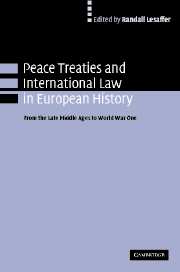Book contents
- Frontmatter
- Contents
- List of contributors
- Acknowledgements
- Table of Treaties
- List of abbreviations
- 1 Introduction
- PART I Peace treaties and international law from Lodi to Versailles (1454–1920)
- PART II Thinking peace: voices from the past
- 5 Vestigia pacis. The Roman peace treaty: structure or event?
- 6 The influence of medieval Roman law on peace treaties
- 7 The kiss of peace
- 8 Martinus Garatus Laudensis on treaties
- 9 The importance of medieval canon law and the scholastic tradition for the emergence of the early modern international legal order
- 10 The Peace Treaties of Westphalia as an instance of the reception of Roman law
- PART III Thinking peace: towards a better future
- PART IV Making peace: aspects of treaty practice
- PART V Conclusion
- Appendix
- Index
5 - Vestigia pacis. The Roman peace treaty: structure or event?
Published online by Cambridge University Press: 07 July 2009
- Frontmatter
- Contents
- List of contributors
- Acknowledgements
- Table of Treaties
- List of abbreviations
- 1 Introduction
- PART I Peace treaties and international law from Lodi to Versailles (1454–1920)
- PART II Thinking peace: voices from the past
- 5 Vestigia pacis. The Roman peace treaty: structure or event?
- 6 The influence of medieval Roman law on peace treaties
- 7 The kiss of peace
- 8 Martinus Garatus Laudensis on treaties
- 9 The importance of medieval canon law and the scholastic tradition for the emergence of the early modern international legal order
- 10 The Peace Treaties of Westphalia as an instance of the reception of Roman law
- PART III Thinking peace: towards a better future
- PART IV Making peace: aspects of treaty practice
- PART V Conclusion
- Appendix
- Index
Summary
Introduction
The problems related to the subject of peace treaties in Roman law are abundant. Not only does the thin evidence of the sources make it difficult to gather a status quaestionis. What do we know about the content and function of peace treaties which have been passed down to us from history? What remains to be discovered? What questions of principle dowe have to ask when it comes to the appropriate methods we should employ? ‘New’ sources, nova reperta so to speak, are only seldom found. Thus, we have to resort to reinterpreting the rather limited amount of well-known sources and to reviewing the older secondary literature to see to what extent it ispossible to make the texts speak to us – rather than being obscured by the interpretations of their own age.
Taking a classical vexata quaestio as our starting point, we will take an overall view of the problems, first of substance and then of method, caused by the peace treaty. From this methodological discussion, we will finally return to our initial question. Even the concept of pax raises the problem whether pax is a legal act or a factual state of being. For our overall view, we first have to ask what can be said about the ‘classical’ international law of ancient Rome as a ‘system’ and especially about the function of the peace treaty within such a system.
- Type
- Chapter
- Information
- Peace Treaties and International Law in European HistoryFrom the Late Middle Ages to World War One, pp. 103 - 146Publisher: Cambridge University PressPrint publication year: 2004
- 2
- Cited by



